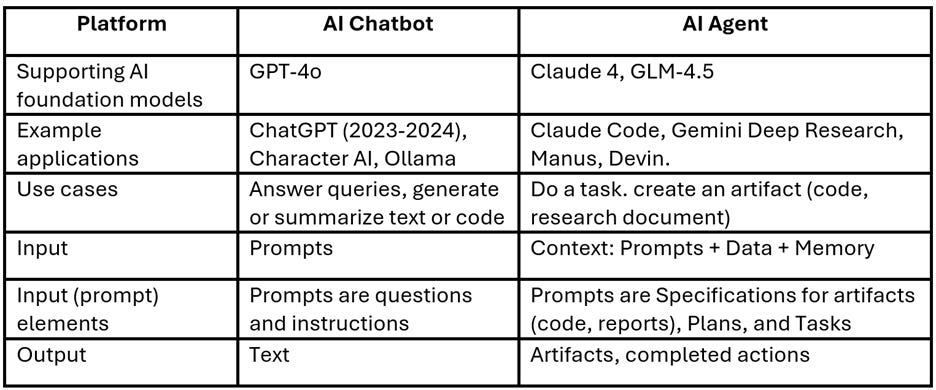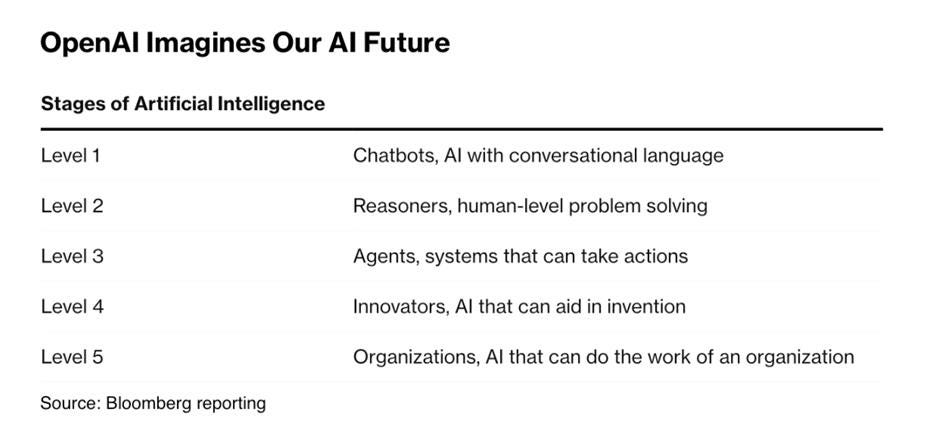The AI Agent Platform Shift
Similar to how Web 2.0 refactored the internet, new AI agents are refactoring what AI can do for us and how to use AI. It’s the AI era’s first platform shift since the ChatGPT moment.
Introduction
The AI revolution is moving so fast, it’s hard to keep up with where we are, let alone predict where we might be a year or two down the road. We are so attuned to AI advancing and doing new things, we may not notice that the rise of highly capable AI agents is creating a platform shift - from AI as chatbots to AI as agents.
This is important for AI users because how to best use and leverage AI agents is distinctly different from how to interact with AI chatbots.
Here’s the TL;DR:
1. AI agents are now reliable, capable, smart, and robust enough for real-world use.
2. This is leading to a platform shift in AI, from AI chatbot to AI agent.
3. The platform shift dramatically changes what AI can do for you, how best to interact with AI, and how to integrate AI into your workflows and daily life.
4. The prompt, whether by voice or text, is still the interface, the main way to direct AI. But what and how you direct AI will shift. Prompt engineering is out, context engineering is in.
5. AI coding agents are the leading use case and tip of the spear for agentic AI, but general AI agents are following the pattern of AI coding agents, in utility, capability, and how they work.
6. Thanks to Model Context Protocol (MCP), capabilities such as web search, coding, research and other skills can now be exposed as tools, making AI agents far more generally capable.
7. AI agents are serving many different vertical applications and are being embedded to make “AI-first” applications. Your browser, IDE, word processor, and even your spreadsheet will soon become agentic applications.
The New AI Agent
The term “Agent” is quite generic and has been used before to describe applications far simpler than today’s leading AI Agents. Simple reflex agents operate on condition–action rules and respond to your environment, so even a smoke detector can be called an agent.
Agents take autonomous actions, so when you combine agents with AI, you get (hopefully) intelligent autonomous action. We expressed this AI Agent definition in Manus and the New AI Agents:
AI agents are autonomous AI systems designed to perceive their environment, make decisions, and take actions to complete specific tasks.
We also described the challenge of AI agents, that until recently they have been “unreliable and fragile.” AI Agents have broken those barriers this year, thanks to several key advances:
Improved AI reasoning: AI models can generate thoughts and plans that make sense and adhere to user intentions.
Tool use integration with Model Context Protocol (MCP) and SDKs.
Better use and management of context, memory and data, including memory features for personalization. AI agents can manage semantic, episodic and procedural memory, so the AI agent has access to needed knowledge bases, can ‘remember’ past interactions, and can personalize AI responses.
As we explained in March in “Design Patterns for Effective AI Agents”:
AI agents are constructed by organizing AI models and ecosystem components, connecting them with AI agent frameworks to execute workflows. The latest AI agents are more powerful because their underlying AI models and AI components are more reliable and capable.
In particular, we cannot underestimate the benefits of tool use standardization with MCP. MCP has given all AI agents tool-using powers, and the standardization has made it easier for AI models to get trained to be good at accessing and calling the right tools.
The AI Agent Platform Shift
More capable AI agents are leading to an explosion in AI agent use and applications. AI agent usage is ramping up rapidly for good reason; they are incredibly useful and productive.
This new development is a platform shift because AI agents dramatically expand what AI can do for you. From an interface perspective, this is a shift from an AI chatbot like ChatGPT to an AI agent, which can be a stand-alone AI agent application, like Claude Code or Manus, or may be embedded in other interfaces or applications. For example, Google search has Agent mode, Perplexity and the latest ChatGPT has an Agent feature.
The “what” in AI agents is that don’t just generate text, they do tasks. The main task for AI coding agents is to create code or other software artifacts, and the main task for AI research agents is to create reports. For these AI agents, it’s an evolution from AI model generation output. However, for AI browsing agents and AI shopping agents, the tasks are not to generate artifacts but complete actions.
The prompt, whether by voice or text, is still the interface, the main way to direct AI. But what and how you direct AI will shift. Prompt engineering is out, context engineering is in. It’s not enough to have a good prompt, you need the full context of prompt instructions, data in context (such as a corporate knowledge base or code base), and memory.
The expansion of prompting to full context to support the AI agent includes several aspects. If you want the AI agent to properly generate an artifact you guide it with a specification. For code, the specification would look like a software requirements specification and design specification. The proper way to AI coding becomes pec-driven AI coding. For research, you specify the task with a research plan and a report outline.
AI agents will follow a Plan-then-Execute pattern for efficient operation. To avoid an AI agent executing incorrect tasks, the user will specify tasks needed or the AI agent will do it in a planning step. The AI agent can define a plan and present it for feedback, then execute it. For example, Gemini Deep Research creates a plan for user review before doing its web research and report generation. Most AI coding assistants now have a planning, for example RooCode has Architect mode.
The platform shift to AI agents is a shift to AI that can take action.

The AI Agent Platform Shift - The Web 2.0 Analogy
The early internet in the 1990s was both amazing and frustrating at the same time. You could access data and even do shopping, but interactions were ‘clunky’ and slow. About a decade after the initial web, a feature called AJAX (Asynchronous JavaScript and XML) was developed, which let you reconstruct a part of a web page without a full HTTP response, avoiding long reload times.
AJAX was a simple but powerful shift in how web applications were built, paving the way for the dynamic, responsive web we use today. Called Web 2.0 at the time, that shift enabled new classes of SaaS (software-as-a-service) applications.
Improved user experience dramatically changed how the internet was used. In the same way, we have experienced major step-changes in AI, first with ChatGPT and now with AI agents. The original Alexa pre-LLM chatbot is quite different from experiencing ChatGPT with GPT-4 in 2023, which in turn pales in comparison to today’s AI agent experience you can have now.

The AI Agent Landscape
AI code assistants have been on the leading-edge of AI adoption. Copilot was the first LLM-based application, and AI coding agents have been the leading use case for agentic AI.
MCP has made it much easier to connect AI models to supporting tools, and the latest AI models have been trained to become much better at selecting and using tools. Many skills and capabilities, including web browsing, coding, and research skills, can be exposed as tools to an AI agent. As a result, any AI agent with MCP support has access to a “Swiss Army knife” of dozens of tools on tap, making AI agents generally capable.
Now, with MCP support, your AI coding agent can be a general AI agent, and applications for AI agents are greatly expanded. These are the basic types of AI agents and categories of agentic AI applications:
AI Research Agents that produce research reports: Gemini Deep Research.
AI Coding Agents that produce code and software applications: They can be terminal (CLI) agents (Claude Code, Gemini CLI); AI coding assistants (Cursor, Windsurf, RooCode); vibe coding tools (Lovable); full software agents (Devin).
AI Browser Agents that browse and take actions on the web: Perplexity Comet; Gemini Project Mariner. Used for shopping, travel reservations, or certain kinds of web data analysis.
General AI agents that are broadly capable of virtual tasks: Manus, OpenHands, ChatGPT Agent (was Operator).
Finally, there are AI agents for enterprise workflows, cropping up across the enterprise:
Platforms like Shopify and Zendesk have AI agents to personalize shopping, handle order inquiries, and resolve customer issues.
ServiceNow’s AI Agent Orchestrator acts as a “control tower” for thousands of specialized agents across IT, HR, and customer service.
Salesforce Agentforce 3 serves enterprise use cases with AI agents with MCP support, prebuilt actions, and observability and governance.
Embedded AI Agents and AI-First Applications
AI agents are also being embedded in applications to make “AI-first” applications.
The Perplexity Comet browser is an example of how the browser is being reconfigured with agentic AI. As we have noted, this is reinventing the browser experience. Comet rebuilt the browser with an AI agent integrated into it, combing AI search and AI assistance within the browser. Microsoft just introduced Copilot Mode in Edge, that integrates chat, search and web navigation.
The IDE (interactive development environment) is evolving in this direction. Many AI coding assistants have been built as extensions of VSCode. As they get more powerful, users will find there is a full AI agent under the hood. Tools like Cursor will end up looking a lot like Cognition’s Devin, while the Devin AI software agent absorbs the capabilities of the Windsurf AI coding assistant.
Over time, most applications will become “AI-first” applications, with an AI agent merged as a feature into the application, ready to exercise that application agentically.

The Road Ahead
We are witnessing an agentic AI revolution, with increased AI agent capabilities leading to releases of many capable AI agents, and an explosion in their popularity and use. This is driving a platform shift for AI.
As we go forward, we can expect more improvements in AI models for agentic use and continued waves of AI agent product releases. We predicted in March “A flood of new AI agents is coming soon.” That flood is here and now.
AI users can expect a lot more from these AI agents than before. Raise your expectations and creatively explore how far you can take agentic AI for your tasks.
This platform shift means AI users need to rethink how to best use AI agents. This means using Context Engineering for best results. You won’t get the benefits of AI by using AI agents like you used ChatGPT in 2023.
Finally, AI progress is on an accelerated time-line. Single AI agents will evolve into hierarchical AI agents, multi-agent AI swarms, embedded AI agents, and ambient AI agents. Each will have different twists on the AI interface and what it can do, and this may supersede today’s AI agents as a platform, but that’s a story for another day.


